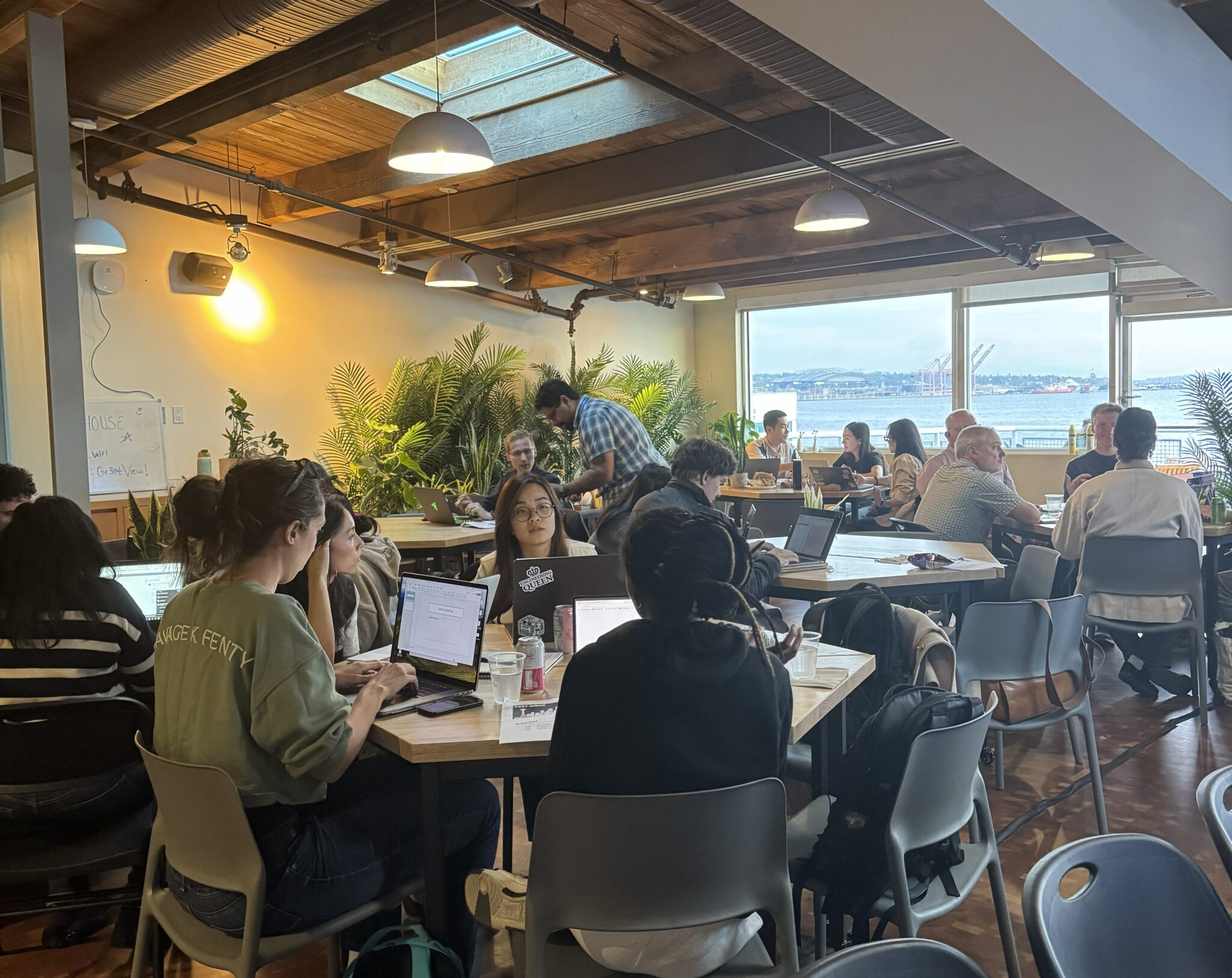
This month, Seattle’s Innovation & Performance Team partnered with the Seattle Department of Construction and Inspections and the AI2 Incubator to host our second Community Innovation Hackathon at the AI House on Seattle’s waterfront.
At this event, teams were challenged to envision the use of data and AI tools to help simplify construction permitting processes, improve teamwork, and focus on what matters—delivering better, faster results.
The Challenge
The Seattle Department of Construction and Inspections (SDCI) is responsible for issuing timely construction permits to help keep our buildings safe. Timely permits keep construction projects on time and on budget and help build Seattle’s housing supply.
However, disconnected systems, complicated rules, and rigid processes have made building in Seattle harder than it needs to be. This slows progress and causes frustration for everyone.
We’ve heard from the community that permits take too long. In response, we have new goals to speed up permitting timelines. To drive that work, the City created the Permitting Accountability and Customer Trust (PACT) team. PACT is designed to improve the speed, predictability, and transparency of permits for housing and small businesses.
Leveraging New Permitting Data
Newly published construction permit performance data shows how long the process currently takes for different types of construction. Importantly, knowing how long things take now has allowed us to set goals for how long we want the process to take in the future.
In addition to setting new goals, the City debuted three new Open Datasets at the hackathon:
- Construction Permits: All building permits issued or in progress within the city of Seattle (one record for each application)
- Plan Review Records: This dataset shows the steps taken in building plan review permits in the City of Seattle
- Correction Review Comments: 26,000 review correction comments by reviewers on select building plan sets for permits issued in 2025
Out of the 30 largest cities in the US, Seattle is one of the only jurisdictions that have published this level of open data on our construction permitting process.
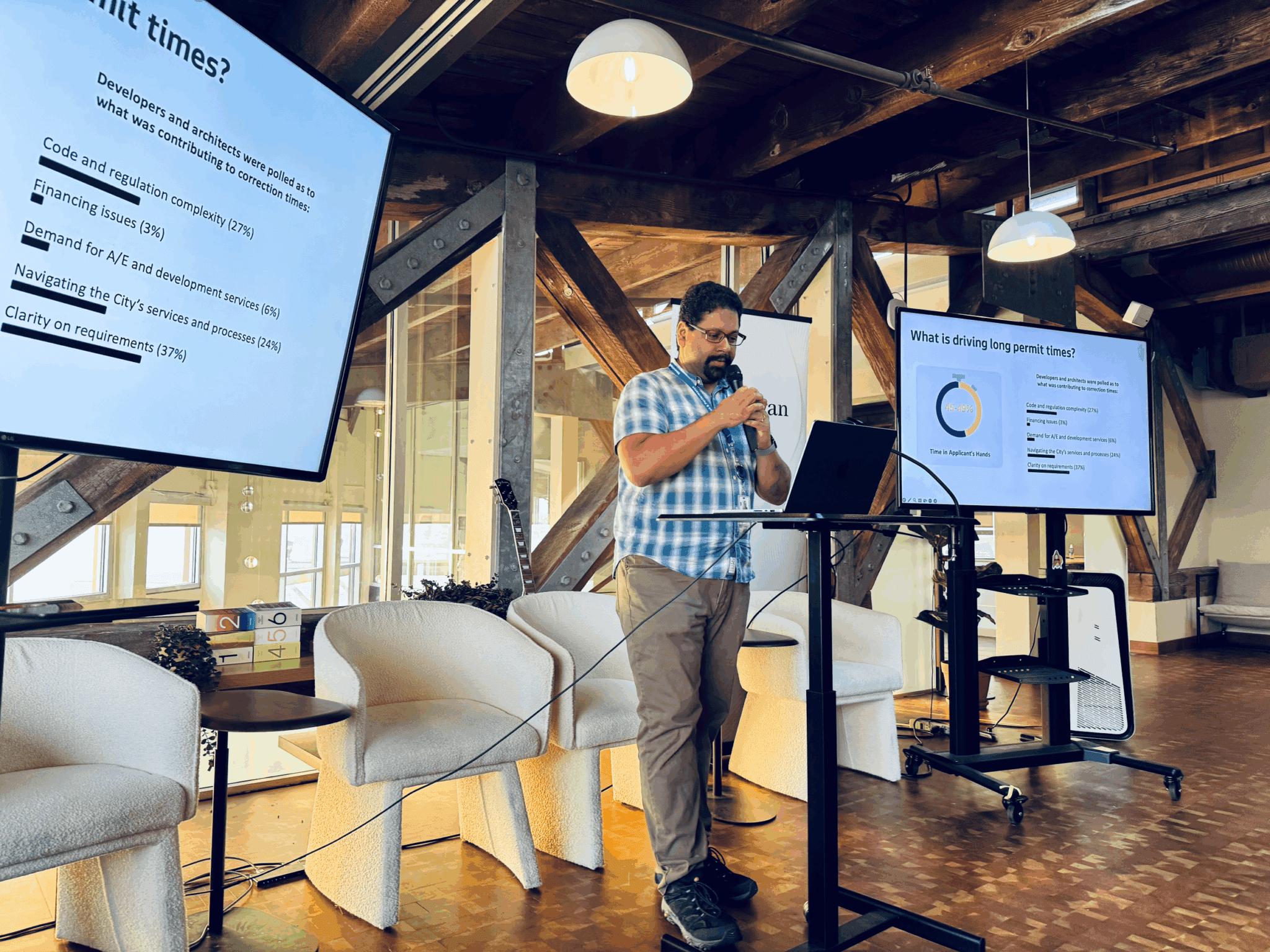
The City’s PACT team challenged our hackathon – or PACTathon – participants to leverage AI and the open data in creative ways that will further our goal of making construction permitting simpler, faster, and more transparent for everyone.
Thank you to all who participated! Our panel of judges had their work cut out for them to narrow down to just three winning projects. The first and second place teams included students from Northeastern University. The third place team came together at the hackathon and included University of Washington Human Centered Design & Engineering students, technology professionals, and architects.
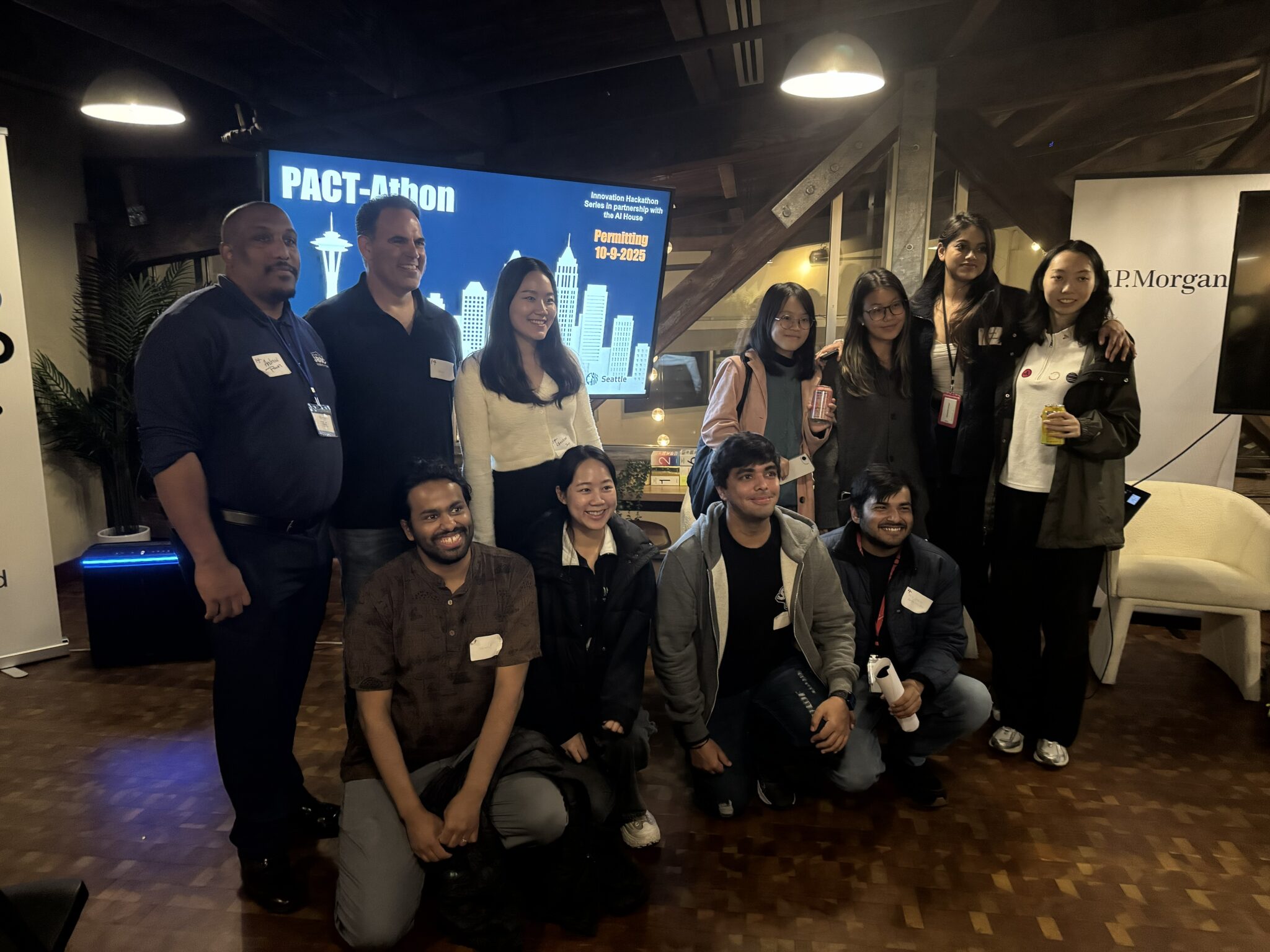
All of the winning teams focused on ways to predict and illuminate the process of permitting for users as early as possible, to enable them to avoid pitfalls and anticipate delays. The PACT team is taking inspiration from their work to build tools that enable users to predict, identify, and avoid pitfalls and delays in the permitting process. The first-place team will also visit City Hall to share their prototype in more detail.
First Place: Team Null
Congratulations to our first place winners, Team Null: Yingzi Liang, Shreya Sundararm, ZiRui Wang, and Lingli Yang. This team developed a “Permit Predictor,” which the team describes as “an AI Predictive Model that takes user’s building details as input, and using the datasets we were provided, predicts the number of expected days to obtain the construction permit, as well as factors causing delays (and also the number of days lost in delay), suggests solutions (and days saved), along with an estimate of review rounds and confidence scores.” Check out their app.
Why did you sign up to participate in this hackathon? Why is this topic important?
Yingzi Liang: We signed up for this hackathon because I think in the surging tide of AI transformation, programmers must refresh their approach to problem-solving. This imperative for modernization is driven by AI itself, and the means of achieving this adaptation can also be assisted by AI tools. Participating in a hackathon offers an excellent way to practice integrating AI into the programming workflow.
Addressing the pain points of complex documentation and redundant procedures is essential to improving municipal service delivery. This initiative leverages AI-enabled tools to streamline processes while actively mitigating the psychological stress and residents often experience when navigating bureaucracy. Our project aims to provide clearer guidance, enhance transparency, and ultimately strengthen public trust in the City’s operations.
Shreya Sundaram: Growing up in Mumbai, India, I witnessed skyscrapers rise beside slums — a daily reminder of stark economic disparities. This experience sparked my curiosity about the causes of poverty and inequality, and over time, my logical thinking led me toward mathematics, data, and computer science as tools to understand and solve such problems. As a student of AI, I’ve always wanted to apply my technical knowledge to create meaningful social impact.
The topic of improving permit efficiency particularly resonated with me because permit delays directly affect housing availability, costs, development and community growth. Leveraging AI to streamline and predict permit outcomes can help cities become more efficient — improving economic productivity.
Lingli Yang: I joined this hackathon because my family and I have personally experienced the challenges of permit delays — the unexpected costs, time loss, and frustration they cause. I’ve always believed that technology should be human-centered. The permitting process affects everyone, from small business owners to residents, and delays can create real financial and emotional burdens. I wanted to explore how data and AI could make public systems more transparent, efficient, and fair for everyone.
ZiRui Wang: I joined the hackathon mainly out of curiosity — I had never participated in one before and wanted to experience the fast-paced, collaborative process of turning ideas into real applications. The topic of using open data and AI for city improvement also resonated with me, as it connects technology with social impact.
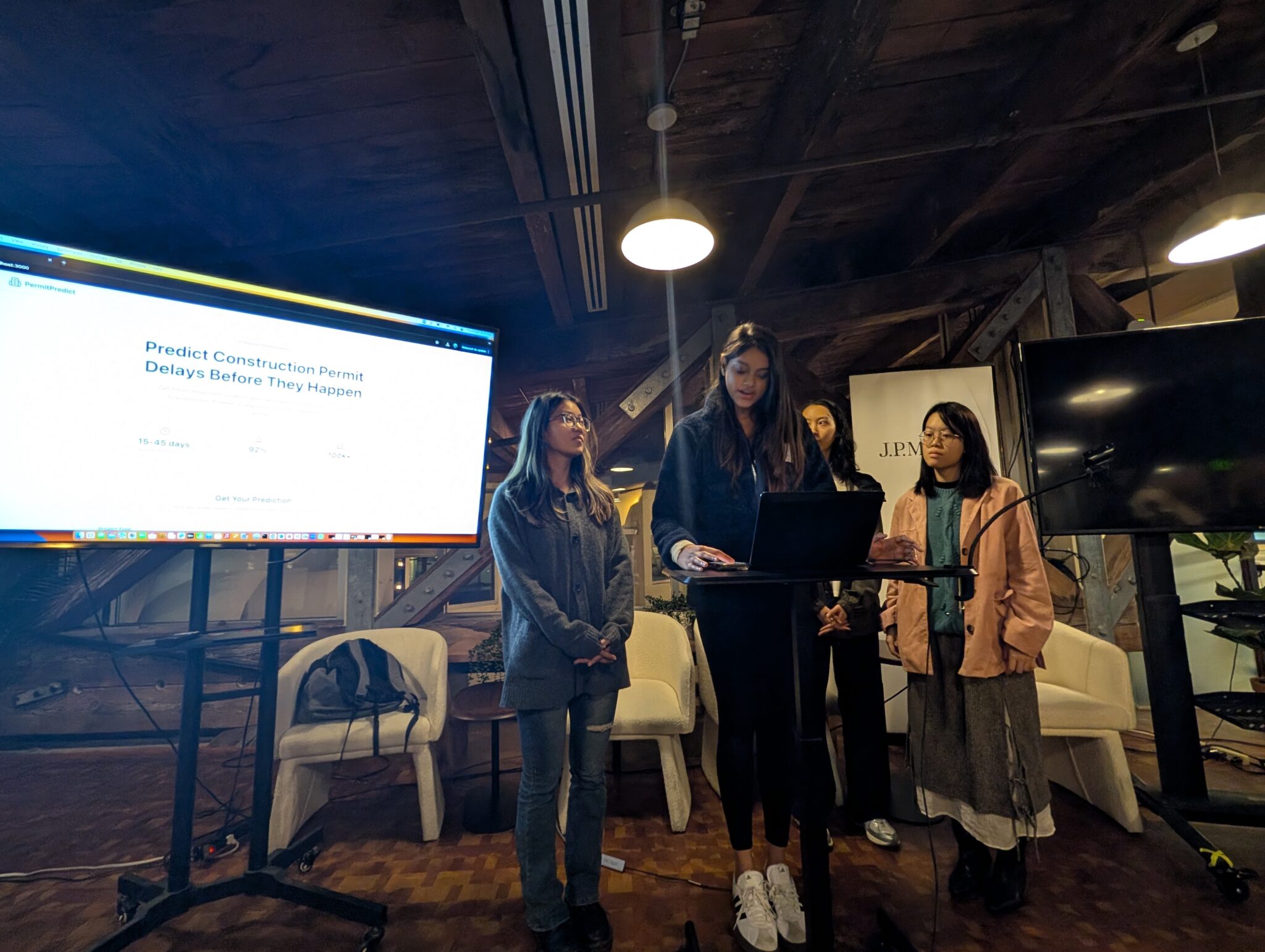
How did you use AI in your project?
Yingzi: After we decided to focus on addressing the challenges faced by applicants, we leveraged Al to generate ideas that helped us identify aspects we had previously overlooked. It also supported our work in interface design and algorithm selection, enabling us to evaluate more user-centered approaches and technical options than we could have considered on our own.
Shreya: We used v0 AI to build both the front-end and back-end components of our predictive model. The system was trained using three datasets, combined with Seattle’s Open API data sources, to ensure accuracy and real-time relevance. I designed detailed prompts to guide the AI in implementing a similarity-based statistical matching algorithm, assigning appropriate weights and formulas to identify key factors contributing to delays. Once these factors were detected, the model was instructed to generate actionable and feasible recommendations for reducing delays.
Throughout the process, I relied on my knowledge of how models are trained and optimized — ensuring that the AI followed logical reasoning steps to produce consistent, data-driven outputs.
Lingli: We built a predictive model using historical permitting data to forecast potential delays and identify their key causes. The AI model analyzes patterns across permit types, review rounds, and project characteristics, and then estimates how much time different improvements could save. This allows applicants to clearly understand where bottlenecks occur and how to optimize their applications.
ZiRui: Our project integrated AI models to analyze city datasets, identify patterns, and generate insights to support more informed decisions. It demonstrated how data-driven tools can make public information more accessible and meaningful.
What are your takeaways from this experience? What did you learn?
Yingzi: I believe that as AI takes on more procedural and repetitive tasks, humans can—and should—focus more fully on our role as strategic decision-makers. By integrating AI into our front-end, back-end, and algorithmic development, we gained the ability to explore multiple architectural pathways and evaluate system design from broader perspectives. This expansion of possibilities enabled our team to concentrate on high-impact decisions and optimization, rather than being constrained by low-level implementation work. Ultimately, I believe this represents a transformative liberation.
Shreya: This experience taught me how to approach problem-solving from a data- and AI-driven perspective, expanding how I think about the potential applications of different models in addressing real-world issues. I learned how predictive modeling can reveal highly accurate insights — in this case, identifying the most influential delay factors and quantifying their impact on project timelines.
Through this process, I gained valuable experience in solving real-world problems, where I had to analyze and consider factors like data quality, computational efficiency, feature selection, and model interpretability. I learned that choosing the right algorithm isn’t just about accuracy—it’s about understanding the trade-offs and constraints of the problem at hand.
Additionally, I developed stronger skills in efficient prompt engineering, while gaining valuable on-the-spot presentation skills during the demo session, where I had to clearly articulate our solution, explain its features, and effectively sell our product to judges and attendees. The hackathon reinforced the importance of persistence, precision, and creativity in working at the intersection of AI and public innovation.
Lingli: This hackathon reminded me that civic innovation is not just about algorithms — it’s about empathy, collaboration, and human impact. Working with teammates from diverse disciplines and applying AI to a real urban challenge reinforced my belief that the most meaningful technology is the kind that truly serves people and communities.
ZiRui: It taught me a lot about working together under time pressure, and it was really inspiring to see how other teams approached the problem from different angles.
Second Place Project: NU Hackers
Congratulations to our second place team, NU Hackers: Mohit Chhabria and Surya Shivam. This team created a smart dashboard and chat bot to answer permit questions and automate compliance checks. You can find their project saved on GitHub.
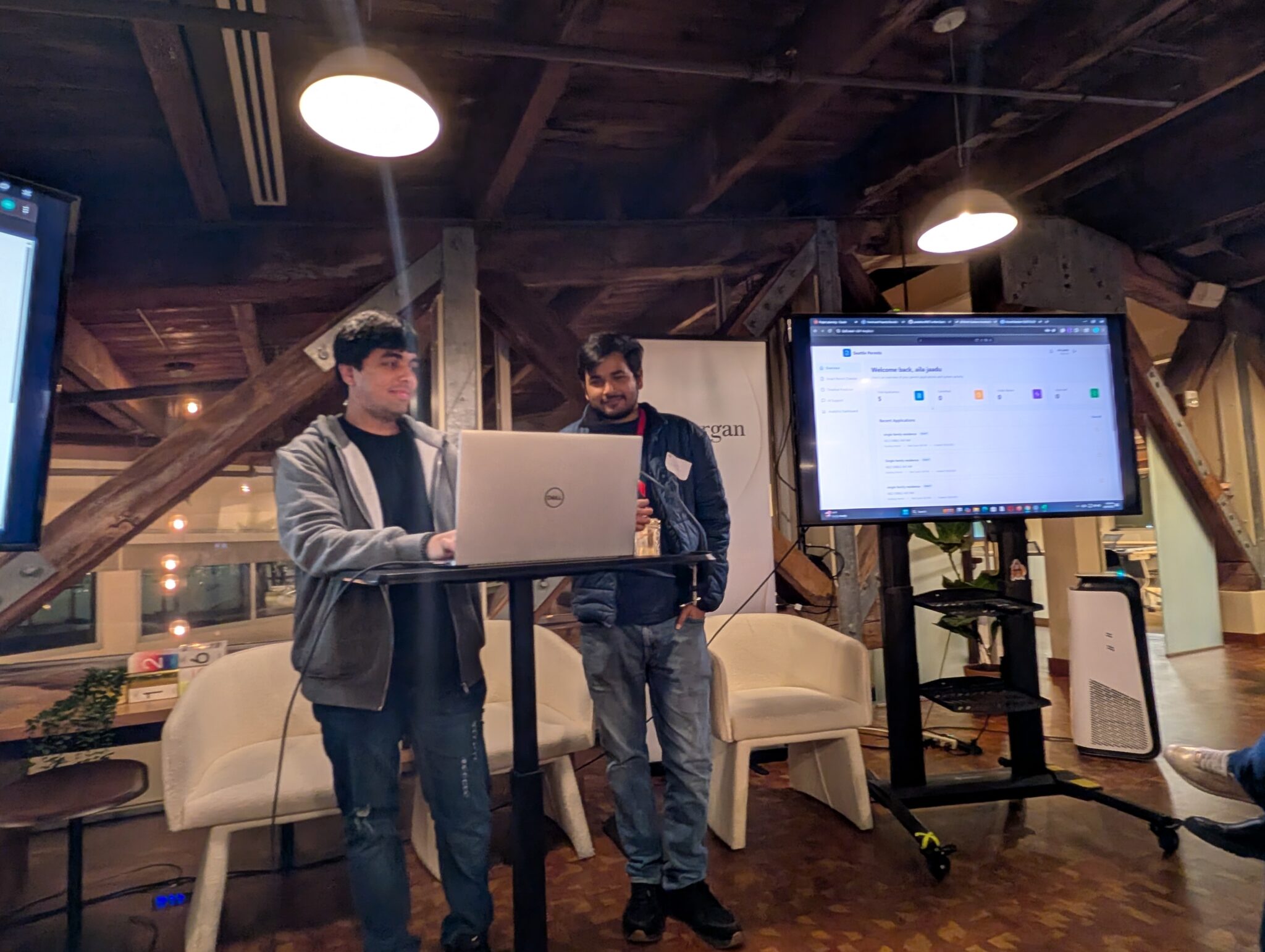
Why did you sign up to participate in this hackathon? Why is this topic important?
Mohit Chhabria: We joined to address the challenge of navigating Seattle’s complex building permit process, which has a direct impact on local development and residents. Efficient permitting is crucial for healthy growth, transparency, and innovation in our city.
How did you use AI in your project?
Mohit: We used Bolt AI to power a smart dashboard and chat bot, enabling instant answers to permit questions and automated compliance checks. AI streamlined information retrieval and helped users resolve permit issues quickly and accurately.
What are your takeaways from this experience? What did you learn?
Mohit: We gained hands-on experience applying AI to real-world urban tech problems. We learned how advanced models like Bolt AI can simplify complex workflows, and strengthened teamwork and rapid prototyping skills in a dynamic setting.
Third Place Project: Team Five Star Rating
Finally, congratulations to our third place winners, Team Five Star Rating—Nawaf Alansari, Kevin O’Leary, Andrew Powers, Christine Tang, and Penny Yeh. The team’s project was called PreAssess, which the team describes as “an AI-powered tool that turns Seattle’s complex municipal code into clear, actionable checklists for residents planning to remodel, plant, or build. It automatically identifies relevant regulations from Titles 22 and 23, generating plain-language requirements with exact setbacks, heights, and compliance steps.” Check out their project saved on Github.
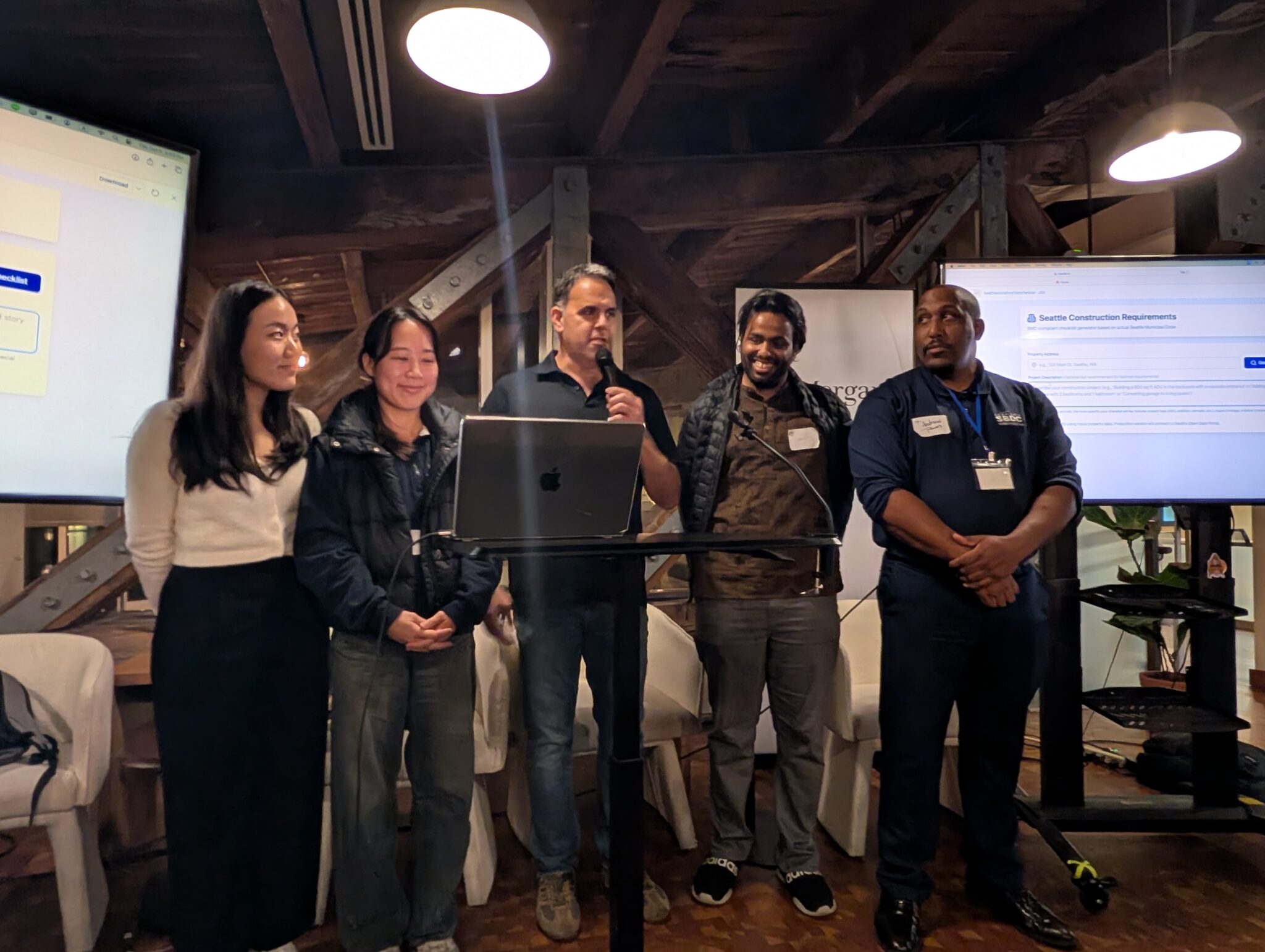
Why did you sign up to participate in this hackathon? Why is this topic important?
Christine Tang: I joined this hackathon because I wanted to connect with other professionals and gain hands-on experience collaborating in a real-world problem space. The topic of improving the permitting process also caught my attention because I once heard a café owner I worked for complain about how long and complicated it was to get the necessary permits when setting up the store. Hearing that made me realize how challenging the process can be for small business owners trying to get started. Even though I wasn’t familiar with this topic, I wanted to challenge myself to design for an unfamiliar problem space and learn from the experience. Since I had heard about this issue before, I was especially interested in understanding the permitting process’s pain points and exploring ways to make it more efficient and user-friendly.
Penny Yeh: I signed up for this hackathon because I wanted to challenge myself and gain experience working with people from different industries on a real-world problem that directly impacts our community. This hackathon particularly spoke to me because it offered the chance to tackle a genuine civic issue, not just a theoretical exercise, giving me valuable project experience while making a meaningful contribution!
How did you use AI in your project?
Christine: Our project uses AI to make Seattle’s construction permitting and zoning codes easier to understand. It processes municipal code documents by extracting and embedding text from legal PDFs, then uses a retrieval-augmented generation (RAG) system to generate plain-language property reports. When a user enters an address or project, the system retrieves relevant code sections and feeds them into an AI language model, which summarizes the information and explains how the regulations apply. This AI-powered approach helps residents and small business owners quickly understand complex permitting requirements without needing to read through dense legal documents.
Penny: We used Claude as our main AI platform for our prototype. Currently, our project translates Seattle Municipal Code regulations into clear, actionable checklists by analyzing project descriptions with natural language processing. When someone types “adding a basement apartment with a deck,” it automatically detects keywords and triggers relevant SMC requirements. While our prototype focuses on SMC requirements and demonstrates how AI could address perhaps 10-15% of the clarity problem, the full vision would integrate all city departments – Seattle Public Utilities for water/sewer, Seattle City Light for electrical, Seattle Fire for access requirements.
What are your takeaways from this experience? What did you learn?
Christine: My main takeaway from this hackathon is the importance of deeply understanding a problem space before jumping into solutions. While our project focused on improving the permitting process, the experience showed me how crucial it is to explore user needs, system constraints, and real pain points in any design challenge. Since we used AI to help create our solution, I learned that being precise and intentional when communicating with AI tools is essential for achieving meaningful results. I also realized that if we don’t fully understand the problem space, we can’t provide the specific details needed for AI to effectively build the platform we envision. Having Kevin, an architect, on our team was incredibly helpful—he explained the permitting process in depth and helped us understand the real challenges professionals face. Through this experience, I gained insight into how obtaining a permit often involves going back and forth between architects and government officials due to missing documents or codes that are open to interpretation, which can lead to differing opinions about a plan. I also really appreciated the teamwork throughout the hackathon; everyone came from different backgrounds and used their expertise to strengthen the project, making the collaboration both productive and inspiring.
Penny: The hackathon taught me a crucial lesson: we spent 1.5 hours defining the problem and only 30 minutes coding and prototyping, but this was key to our success. We initially tried tackling Seattle’s complex tree regulations, but realized it was too ambitious for two hours. The breakthrough came when our teammate Kevin from the architecture industry shared his real-world frustration: applications constantly get rejected due to unclear requirements and complex regulations. This pivotal insight shifted our focus to solving the broader rejection and re-submission problem. Our solution ended up addressing both major permit delay drivers: code complexity (27%) and clarity on requirements (37%), representing nearly two-thirds of all delays. We came up with a tagline for our project, ‘Getting it Right from the Start,’ which reflects our approach: investing time upfront to truly understand the problem. Despite having only 30 minutes to prototype, our clear problem definition enabled us to build something that demonstrates a path to addressing 64% of the pain points, even if our prototype only scratches the surface of what’s possible.
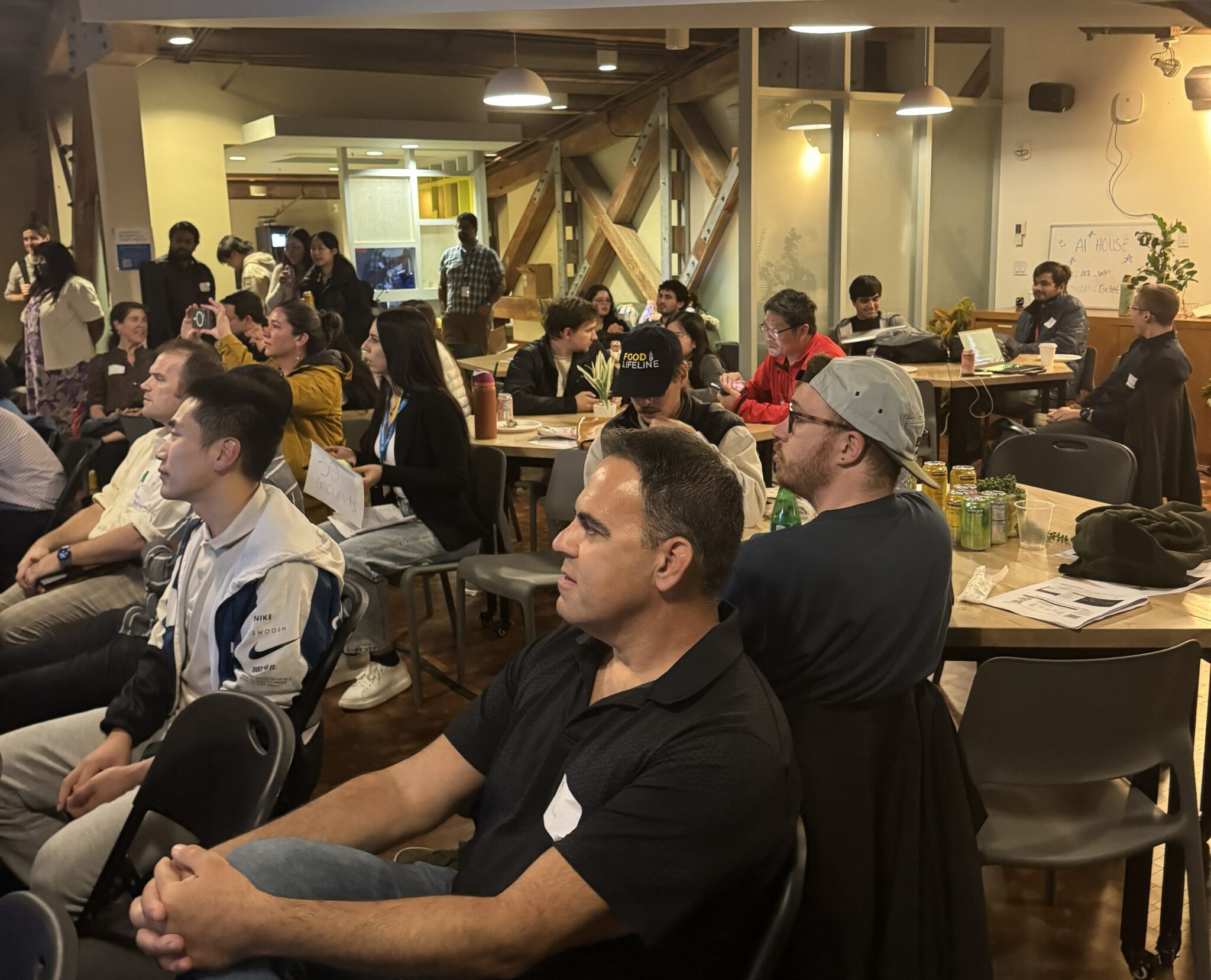
Special Thanks to Our Judges
We were honored to have a panel of incredible judges:
- Sujata Sridharan – AI House Resident Expert
- Shilpa Shastri – AI House Resident Expert
- Tina-Marie Gulley – CEO at Ada Developers Academy
- BJ Ezeli – Strategic Advisor at City of Seattle Dept. Of Construction and Inspections
- Lisa Rutzick – Customer Experience Product Manager at City of Seattle Dept. Of Construction and Inspections
- Micaela Simeone – Noble Reach Fellow from City of Seattle’s Innovation and Performance team
Special Thanks to Our Partners
This hackathon was possible thanks to support from our partners:
- AI2 Incubator supports early-stage AI startups by providing mentorship, funding, technical resources, and community to help them rapidly develop and scale their ideas.
- We Build With AI is a community of AI experts that empower people to rapidly prototype and launch projects using AI through hands-on workshops, hackathons, and collaborative events.
- Bolt is an AI-powered code editor that lets you instantly prototype, build, and deploy full-stack web apps in your browser with minimal setup.
- Ada Developers Academy’s mission is to prepare women and gender expansive adults to be software developers while advocating for inclusive and equitable work environments.
👷♀️ Learn more about Seattle’s permitting performance goals
📰 Learn about Seattle’s Responsible AI Plan
👩🏫 Check out the winning project from our first Community Innovation Hackathon
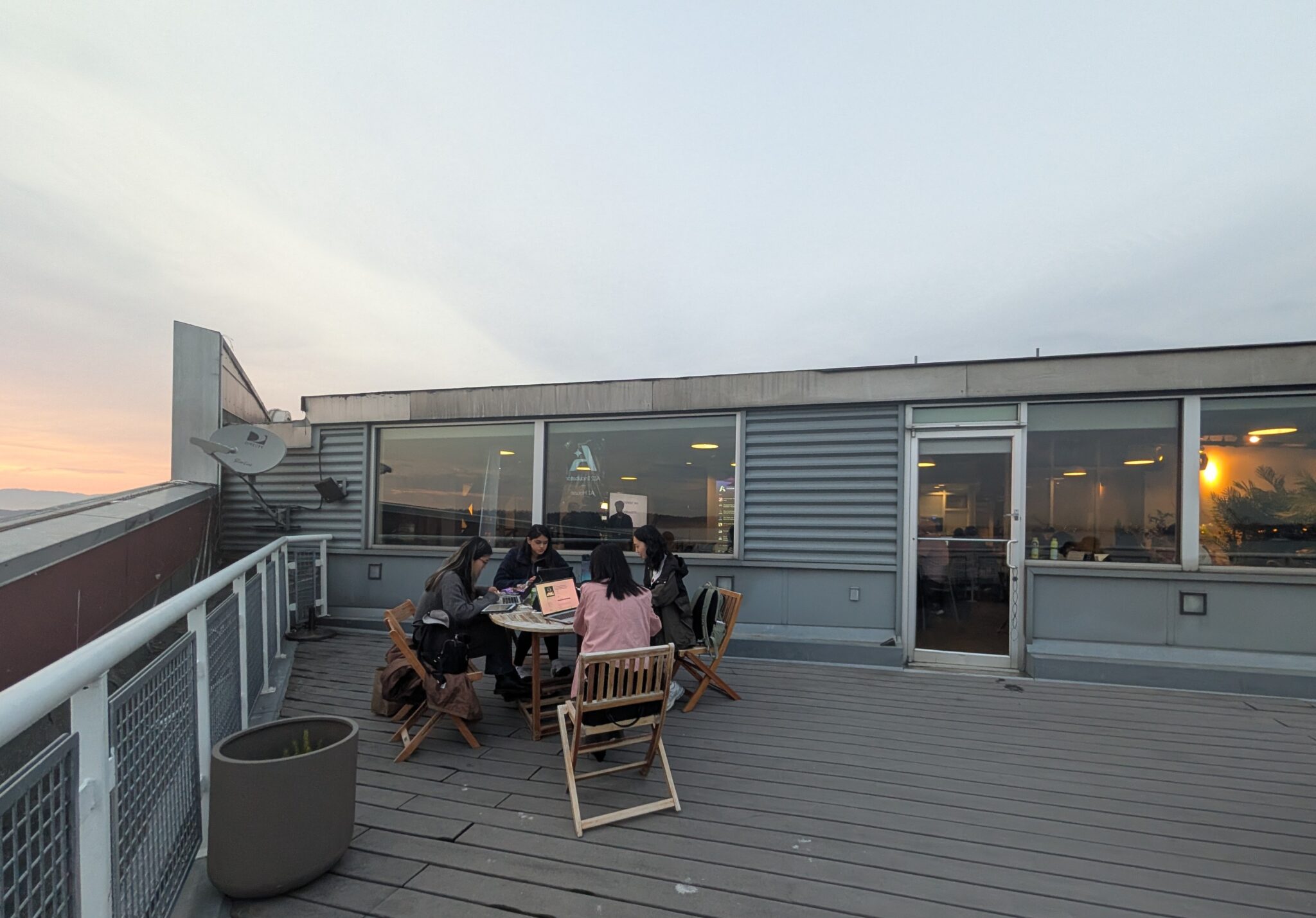
Join Us for the Next Hackathon on November 6!
Want to bring your ideas to the next civic challenge? Registration is currently open for the last Community Innovation Hackathon of the year on November 6, this time focused on improving Seattle’s approach to customer service. Secure your spot today: luma.com/pactathon2